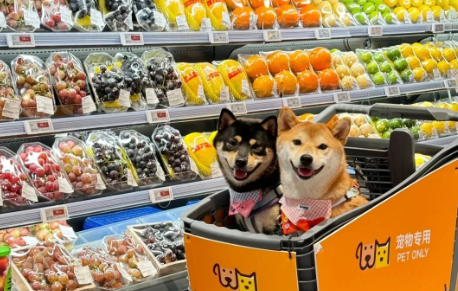Pet-Friendly, Not Just Friendly to Pets
Let’s talk about a topic that consistently draws practical attention every year—pets. Although pet-friendly malls are nothing new, the potential of the pet economy is always full of both inflated myths and delightful surprises. Here, let’s take a look at some data.In 2024, the consumption scale of urban cats and dogs in China has surpassed 300 billion RMB, with a year-on-year increase of 7.5%, and it’s expected to grow further to 331.1 billion RMB in 2025. The consumption structure remains stable, with pet food still being the core. Pet food holds a dominant market share of 52.8%, followed by the medical market at 28.0%, and pet products and services at 12.4% and 6.8%, respectively. The 90s and 00s generations have become the main drivers of pet ownership, accounting for 66.8%, with the percentage of pet owners born after 2000 rising from 10.1% in 2023 to 25.6%.Today, let’s explore the pet economy in 2025, looking at opportunities and differentiated thinking from the pet market itself, commercial consumption categories, and most importantly, the people who are willing to spend money on their pets.From Physical Health to Mental Health: Pet Economy Enters a New Competitive Phase.In the past few years, pet-friendly amenities have been a way for malls to differentiate themselves, such as dedicated pet toilets, elevators, water stations, strollers, and pet parks. However, as more and more malls adopt these features, they have become the standard. We then found that pet retail consumption in these spaces remains lukewarm. Unlike human-centered services, which can thrive through fine-tuned differentiation within the same category, pet retail doesn’t yet exhibit such nuanced variation.
A significant reason for this is that most people still treat pets as “objects.” Whether it’s a cat, dog, reptile, or bird, pets are often seen as a form of self-indulgence. People buy them cute clothes, take pictures, purchase fancy gifts and beds, celebrate birthdays, and enter competitions, all of which are driven by human imagination and needs.Currently, the pet economy bubble is still large. However, for the 90s and 00s generations—who are mostly satisfied with basic living needs and come from generally better educational backgrounds—pet ownership has begun to focus more on interaction. As they move away from traditional societal connections like marriage, employment, and childbirth, they start to build “new relatives” based on personal experiences and self-affirmation. This shift makes the pet development trend far more interesting.Indeed, based on the data mentioned earlier, 66.8% of pet owners now place more emphasis on high-end, personalized, and refined consumption demands. They are more willing to spend on smart, eco-friendly products and, just like researching their own health food, start exploring their pets’ nutrition, mental health, grooming, and social needs. Equal respect is where true listening begins.The same principle applies here: just as we ask children what they want to learn not only to avoid wasting money but also to reinforce the belief that “you must stick to what you choose,” pet consumption driven by vanity and curiosity doesn’t last.

Increased Pet Consumption Across All Aspects.We see a significant increase in pet consumption across all stages of service. For example, pet boarding and in-home pet care services in first-tier cities have evolved from basic cages to spaces offering more options, such as allowing cats or dogs to interact with one another or enjoy private, undisturbed spaces.Additionally, services like pet funeral and memorial services, such as pet funerals, pet memorial dolls made from a deceased pet’s fur, and pet hospital memorial services, have become increasingly common. These are ways to treat the end of a pet’s life with the same respect as the life itself—valuing the process rather than discarding the pet like an object that has outlived its usefulness.There’s also a growing market for pet health supplements, weight loss programs, and fitness services. We realize that whether as business creators listening to the market or as consumers, adopting a mindset of mutual respect rather than just trying to lead (or manipulate) the consumer’s behavior might yield far better results.Shifting from Cats and Dogs to Exotic Pets.Behind the growing pet economy, there is an increasing diversity of pet types. While cats and dogs still dominate, exotic pets like fish, birds, reptiles, and insects are gradually becoming more mainstream at pet exhibitions. In fact, as of 2024, approximately 17.07 million people in China are raising exotic pets, with an increasing percentage of reptile owners—up 2.9% to 11.3%.
This reflects the growing individuality of modern consumers, showcasing more pet diversity and reflecting society’s changing values. This shift in pet ownership—from traditional cats and dogs to more exotic options—provides an exciting new business avenue, representing a change in how we view relationships with pets. For many pet owners, it’s less about “playing” with the pet and more about coexisting with it, observing it, and building a bond.From this, we can see that there’s a correlation between the kind of pet someone owns and their personality traits. Although this may not always be accurate, it serves as a useful reference for categorizing consumers. Similar to how people use zodiac signs or MBTI to understand themselves, this analysis helps marketers quickly identify and establish relationships with potential customers.For example, in Japan, a 2023 survey found that the majority of cat owners cited “providing tranquility” as their primary reason for owning a cat, whereas dog owners were more likely to be motivated by “companionship” and “improving family relationships.” This suggests that cat owners may be more introspective, while dog owners might be more social.In fact, the key takeaway from these insights is the need to understand the diverse motivations behind pet ownership. The future of pet consumption lies not just in the pets themselves, but in understanding the unique individuals who own them. Understanding these consumers’ preferences, behaviors, and emotional needs will define the future of the pet economy.